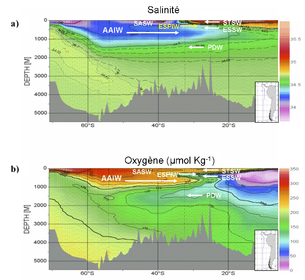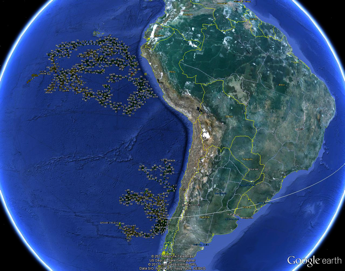The main objective of the FLOPS project was to deployed 20 ARGO floats along the Chilean and Peruvian coasts in order to study i) the vertical water mass structure in the eastern Pacific, ii) the subsurface oxygen minimum zone observed in the eastern South-Pacific and iii) the vertical thermohaline structure of the observed meso-scale eddies. Some of the floats deployed as part of this program were equipped with oxygen sensors.
FLOats from the Southeast Pacific
by G. Eldin*(a) and A. Chaigneau(a)
* Corresponding author : Gérard Eldin
(a) : LEGOS Toulouse, France
Scientific Interest
The Southeast Pacific Ocean [5°S-40°S and east of 110°W], off the coastline of Peru and Chile, is a key region where the oceanic circulation connects the tropical latitudes and the high southern latitudes by transporting water masses of diverse origins (equatorial, subtropical, subantarctic ou antarctic). Along the south-american coastline, the surface circulation is characterized by a diffuse northward current, associated with the return current of the subtropical gyre. On the contrary, the subsurface current of Peru-Chile transports warm, salty, low oxygen and nutrient rich equatorial subsurface waters (ESSW) southward along the continental shelf [e.g. Strub et al., 1998]. Influenced by coastal winds, this water rises in the surface layers and thus promote phytoplankton production conducive to an incredible organic production [Chavez et al., 2008]. Degradation of the organic matter is a major contributor to the presence of an oxygen minimum zone (OMZ) in the subsurface, which extends from the coast to several hundred kilometers wide, and tens to hundreds of meters deep [Karstensen et al., 2008; Fuenzalida et al., 2009].
While this largest and most pronounced OMZ in the world plays an essential role in the production of greenhouse gas emissions [Paulmier et al., 2008] and the structure of the ecosystem [Bertrand et al. 2010, 2011], its spatial distribution and thickness are still poorly understood. In addition, superimposed on the large-scale circulation of the southeast Pacific, energetic mesoscale eddies play an important role in the transfer of physico-chemical properties from the coastal region to open sea. This intense mesoscale activity has been already observed from hydrographic data [Blanco et al., 2001] and satellite [Hormazabal et al., 2004; Chaigneau and Pizarro, 2005] but the vertical structure of the eddies was still unknown before the FLOPS project.
Figure 1 : Salinity (a) and dissolved-oxygen concentration (b) distribution along the section WOCE-P19 off the south-american coastline. Main water masses : Subtropical Surface Water(STSW) ; SubAntarctic Surface Water (SASW) ; East-southern Pacific Intermediate Water (ESPIW) ; Equatorial SubSurface Water(ESSW) ; Antarctic Intermediate Water (AAIW) ; Pacific Deep Water (PDW).
Therefore, the FLOPS project had three main objectives, defined as follows :
- Document the water masses and their variability in the South-East Pacific
- Document the OMZ hydrology, specifying in particular the distribution of dissolved oxygen in the suboxic layers
- Analyze the vertical structure of mesoscale eddies of current Chile-Peru, by performing a comparative analysis of satellite measurements (altimetry, sea surface temperature, ocean color) and ARGO float data
To achieve these objectives, the project plans to improve the sampling of the region [70°W-80°W, 4°S-37°S] by the deployment of 20 profiling floats, especially obtained in the framework of GMMC annual call for tender for the years 2006-2007.
Data and Methodology
The FLOPS project allowed thus the deployment of 20 Argo floats in 10 sites along the west caostline of South-America (see fig.1). Those deployments have been done between 2006 and 2010 by the Chilean (University of Concepcion) and Peruvian (IMARPE) colleagues involved in the project, and thanks to the deployment of opportunity (Campaign STRATUS, R/V Ron Brown, NOAA, 2007).
All deployed floats were PROVORs built by the MARTEC company and prepared and programmed by the deployment team of Ifremer Brest. All floats were programmed to drift at 1000m and profile between the surface and 2000m every ten days. Eight of those twenty 20 PROVORs were equipped with Aanderaa-type oxygen sensors financed by IRD institute. Among the 20 floats deployed, three of them have been lost upon launching, and three others ar estill cycling at the end of march-2013.
Figure 2 : Map of FLOPS floats trajectories until the end of march 2013.
Main Results
The main work carried out to the current date from FLOPS floats and other deployments in the South-East Pacific focused on the meso-scale eddies dynamics [Chaigneau et al., 2011], and validation of PROVORs oxygen dissolved measurements [Eldin and Chaigneau, 2011]. Data from Argo floats were also incorporated into a database IMARPE to build regional climatologies of temperature, salinity and dissolved oxygen in the Southeast Pacific region, allowing better description of water masses in the study area [Grados et al., 2008; Angulo et al., 2010]
The figures below illustrate some of the results:
Figure 3 : Mean vertical structure of cyclonic eddies (TC) and anti-cyclonic (TA) and associated anomalies, calculated from the CARS climatology. The figure shows the vertical profiles of temperature anomalies (a), salinity (b) and density (c) in the TC (blue) and TA (red) and outside eddies (black). According Chaigneau et al., 2011.
Figure 4 : Comparisons of measurements of dissolved oxygen for 2 FLOPS floats equipped with sensors Aanderaa 3830. The data are corrected for pressure and salinity, and anomalies calculated relative to the annual climatology WOA09. The figure shows that there is a systematic bias of about 10 mM/m3 on these measures, however, the temporal drift of 4 years is very low, ranging from 0 to 2 mM/m3/an depending of floats or depth. According Chaigneau and Eldin, 2011.
References
- Angulo K., A. Chaigneau, M. Graco, J. Ledesma, G. Flores & O. Morón. 2010. Climatología de oxígeno para el sistema de la Corriente de Humboldt, '2º Congreso de Ciencias del Mar del Perú', Piura, Peru, 24 - 28 May 2010
- Bertrand A, Chaigneau A, Peraltilla S, Ledesma J, Graco M, F. Monetti, F. P. Chavez, 2011, Oxygen: A Fundamental Property Regulating Pelagic Ecosystem Structure in the coastal Southeastern Tropical Pacific. PLoS ONE 6(12): e29558. doi:10.1371/journal.pone.0029558.
- Bertrand A, Ballón M, Chaigneau A, 2010. Acoustic Observation of Living Organisms Reveals the Upper Limit of the Oxygen Minimum Zone. PLoS ONE 5(4): e10330. doi:10.1371/journal.pone.0010330
- Blanco, J. L., A. C. Thomas, M.‐E. Carr, and P. T. Strub , 2001, Seasonal climatology of hydrographic conditions in the upwelling region off northern Chile, J. Geophys. Res., 106, 11,451–11,467, doi:10.1029/2000JC000540.
- Chaigneau, A., and O. Pizarro, 2005b, Mean surface circulation and mesoscale turbulent flow characteristics in the eastern South Pacific from satellite tracked drifters, J. Geophys. Res., 110, C05014, doi:10.1029/2004JC002628.
- Chaigneau A., M. Le Texier, G. Eldin, C. Grados, O. Pizarro, 2011, Vertical structure of mesoscale eddies in the eastern South Pacific ocean: a composite analysis from altimetry and Argo profiling floats, J. Geophys. Res., 116, C11025, doi 10.1029/2011JC007134.
- Chavez, F., A. Bertrand, R. Guevara‐Carrasco, P. Soler, and J. Csirke (2008), The northern Humboldt Current System: Brief history, present status and a view towards the future, Prog. Oceanogr., 79, 95–105, doi:10.1016/j.pocean2008.10.012.
- Eldin G., A. Chaigneau, 2011, Data return from Argo floats with DO sensors, Argo-France Annuall Workshop, Brest, juin 2011
- Fuenzalida, R., W. Schneider, J. Garcés‐Vargas, L. Bravo, and C. Lange (2009), Vertical and horizontal extension of the oxygen minimum zone in the eastern South Pacific Ocean, Deep Sea Res., Part II, 56, 992–1003, doi:10.1016/j.dsr2.2008.11.001.
- Grados, C, A. Chaigneau, A. Harang, L. Vasquez, M. Graco, J. Ledesma, J. Habasque, B. Dewitte, V. Echevin, G. Eldin, 2008. A regional climatology of the North Humboldt Current System off Peru. International symposium “Eastern Boundary Upwelling Ecosystems”, Las Palmas, Gran Canaria, 1-6 june 2008
- Hormazabal, S., G. Shaffer, and O. Leth, 2004, Coastal transition zone off Chile, J. Geophys. Res., 109, C01021, doi 10.1029/2003JC001956
- Karstensen J., L. Stramma, M. Visbeck, 2008, Oxygen minimum zones in the eastern tropical Atmlantic and Pacific Oceans, Prog. Oceanogr. 77, 331-350.Paulmier A, Ruiz-Pino D, Garc¸on V (,2008,) The Oxygen Minimum Zone (OMZ) off Chile as intense sources of CO2 and N2O. Cont Shelf Res 28: 2746–2756
- Strub, P. T., J. M. Mesias, V. Montecino, J. Rutlant, and S. Salinas (1998), Coastal ocean circulation off western South America, in The Sea, vol. 11, edited by A. R. Robinson and K. H. Brink, pp. 273–313, John Wiley, Hoboken, N. J.




